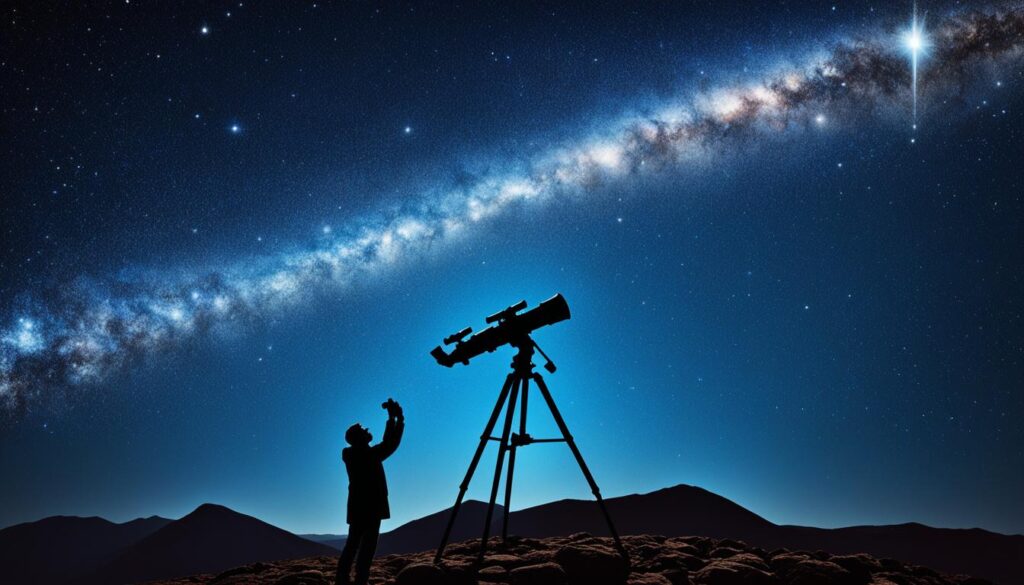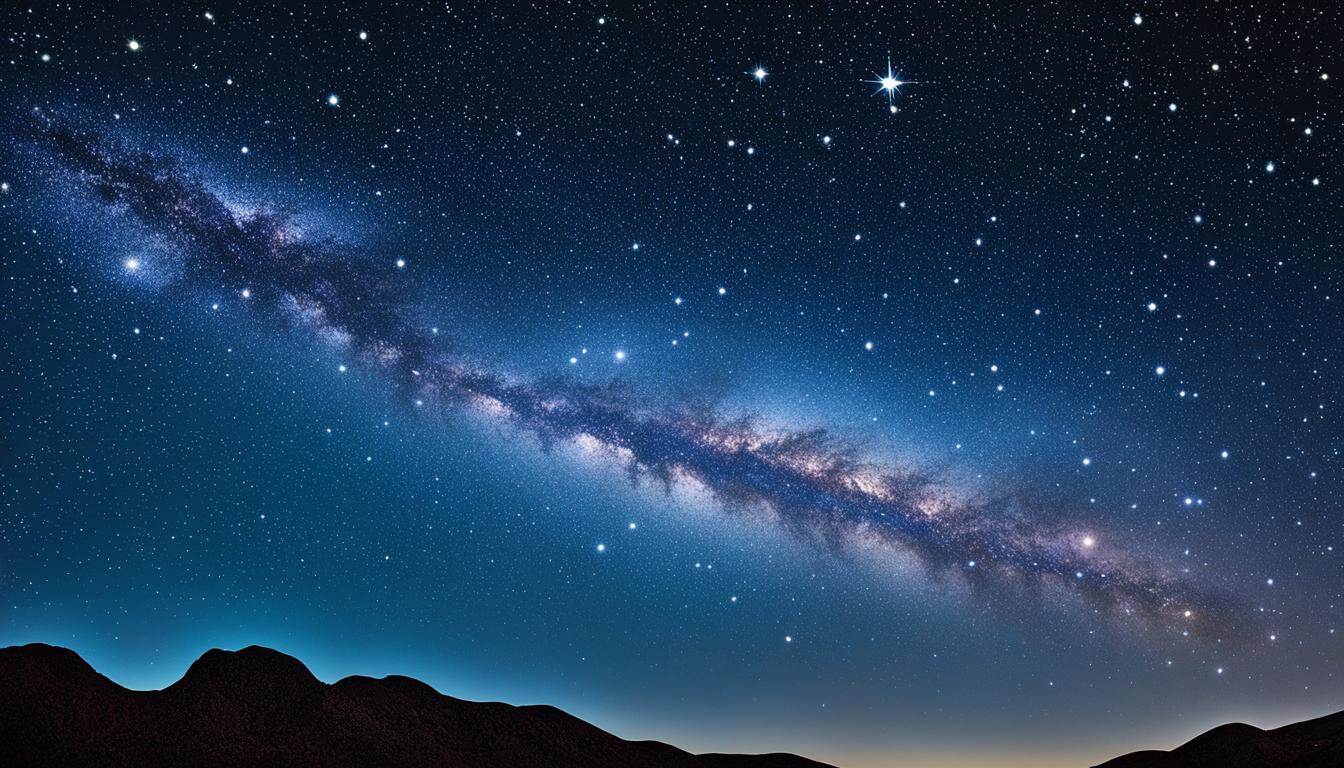The heavens above us are a stage for the magnificent dance of stars that sketch out a spectacular array of patterns and shapes. Among these celestial masterpieces is the **Great Diamond Asterism**, a celestial wonder that graces the spring sky with its luminescent charm. Formed by the intertwining of four brilliant beacons from disparate constellations, this astronomical phenomenon beckons you to gaze upward and admire its grandeur.
Spanning a canvas far wider than the famed Big Dipper, the Great Diamond Asterism is a visual treat for both amateur stargazers and seasoned astronomers alike. From the piercing blue-white of Spica to the mellow amber glow of Arcturus, each star in this ensemble contributes to a celestial narrative that has been revered through ages. As your eyes trace the lines between these stellar giants, you’re not just observing an optical wonder—you’re walking in the footsteps of countless observers who have, throughout history, looked to the stars for guidance and inspiration.
Key Takeaways
- Witness the impressive expanse of the **Great Diamond Asterism**, larger than the Big Dipper.
- Embrace the best viewing experience during spring evenings from the Northern Hemisphere.
- Discover the individual brilliance of the stars Cor Caroli, Arcturus, Spica, and Denebola coming together to form the asterism.
- Unfold the rich historical and cultural narratives associated with the Great Diamond’s celestial cast.
- Employ the asterism as a stellar guidebook to navigate and explore the surrounding celestial wonders and galaxies.
Discovering the Great Diamond Asterism in the Night Sky
As you gaze upon the vast canvas of the night sky, the Great Diamond Asterism stands out as a spectacular optical phenomenon, inviting both seasoned and novice stargazers to explore its mysteries. This celestial object is not just a mesmerizing pattern of stars but also an intriguing astronomical phenomenon that captures the imagination.
What Is the Great Diamond Asterism?
Encounter the Great Diamond Asterism, or the Virgo Diamond—a captivating star formation that ties together four brilliant stars from disparate constellations. For those passionate about stargazing, the asterism’s expansive presence, surpassing even the Big Dipper, offers an unforgettable celestial showcase on spring evenings.
Best Time to View the Great Diamond Asterism
Spring evenings serve as an ideal backdrop for observing the Great Diamond, as the Northern Hemisphere aligns to unveil this astronomical phenomenon. With clear skies and the right timing, the diamond-shaped star pattern emerges in its entirety, promising a stargazing session full of wonder.
Identifying the Diamond-Shaped Star Pattern
To embark on this cosmic quest, seek the four luminaries that craft the asterism’s distinct angles: Cor Caroli, Denebola, Spica, and Arcturus. Each star a beacon, together they form a diamond-shaped star pattern that guides your eyes through the cosmos, transforming celestial objects into a map etched in the heavens for your stargazing delight.
Whether you are a burgeoning astronomy aficionado or a seasoned observer of the night sky, the Great Diamond offers a glimpse into the splendor of our universe and the celestial dance of its stars. Venture out on a clear spring night, and let the spectacle of the Great Diamond Asterism become a jewel in your collection of stellar memories.
Astronomical Marvel: Understanding the Stars of the Great Diamond
When you gaze skyward at the rare celestial event unfolding above you, the Great Diamond asterism is one celestial wonder that never fails to mesmerize. Each of the bright stars that anchor its corners is a marvel in its own right, with a story that enhances its splendor in the canvas of the cosmos.
Arcturus, an orange giant star, is a beacon in the sky and stands as the fourth brightest star that we can observe. Beyond its brilliance, it is a cornerstone in the celestial architecture that savvy stargazers can locate by trailing the arc of the Big Dipper’s handle.
Spica is Virgo’s sparkling gem, the brightest star within the constellation. It’s not only a visually significant star; Spica is a binary system composed of two stars so close together that they are egg-shaped rather than spherical. This rotating ellipsoidal variable star adds complexity and beauty to the celestial narrative.
Denebola, the tail of the celestial lion, Leo, is a hot white main sequence star. It marks an apex of the Great Diamond, contributing a cooler hue compared to its counterparts in the asterism.
Cor Caroli, a binary star, twinkles with a light that varies ever so gently in brightness – a fitting tribute to the memory of King Charles I of England, for whom it was named. Cor Caroli concludes our quartet of astronomical wonders within the Great Diamond.

Your exploration of these luminous guides offers more than just knowledge; it’s a journey across history and space. Comprehending the brilliance and intricacies of each of these bright stars serves to deepen your connection with the night sky — a tableau of ancient myths, navigational aids, and stories of our collective past. In these stars, you find not only the markers of a celestial wonder but also the enduring legacies of the universe’s grandeur. Let the Great Diamond lead you to understand the majesty of our celestial neighborhood.
Navigating Celestial Objects Within the Great Diamond
The spectacle of the night sky is filled with wondrous sights, and the Great Diamond asterism is a treasure trove for enthusiasts of natural beauty and celestial objects. Within this majestic array, constellations and star formations offer a feast for the amateur stargazing community. As you immerse yourself in the cosmos, here’s how to traverse the starlit expanse and uncover the mysteries it holds.

Coma Berenices and Its Stellar Composition
Lying gracefully within the bounds of the Great Diamond, the constellation Coma Berenices reveals itself with an open star cluster, Melotte 111, which spans a generous five degrees across the sky. This optical phenomenon is a guidepost for those charting their path across the cosmos and is a component of the star formation that amateur astronomers can observe with sheer delight.
Exploring Nearby Galaxies in the Virgo Cluster
Adjacent to this constellation, the Virgo Cluster presents a gathering of nearby galaxies that are a marvel to behold. These celestial objects, including notable Messier galaxies like M49, M60, M84, and the luminous M87, are sprinkled throughout the area, embodying the natural beauty of our universe and inviting observers to peer deeper into the void.
Amateur Stargazing Tips for the Great Diamond Asterism
To fully appreciate the grandeur of the Great Diamond, specific stargazing tips can enhance your experience. Armed with a telescope, you can unveil celestial wonders such as the Black Eye Galaxy, Whale Galaxy, and the slender sliver of the Needle Galaxy that all lie within this star formation’s grasp.
| Celestial Object | Constellation | Type | Messier Catalog |
|---|---|---|---|
| Black Eye Galaxy (Messier 64) | Coma Berenices | Spiral Galaxy | M64 |
| Whale Galaxy (NGC 4631) | Canes Venatici | Barred Spiral Galaxy | — |
| Needle Galaxy (NGC 4565) | Coma Berenices | Spiral Galaxy | — |
| Luminous M87 | Virgo | Elliptical Galaxy | M87 |
The Cultural and Historical Significance of the Great Diamond Asterism
As you gaze skyward at the celestial event known as the Great Diamond Asterism, you are not simply observing a collection of stars; you are witnessing a tapestry rich in historical significance. This star formation has not only played a pivotal role in the stories and myths of ancient cultures but has also been personified through the ages to reflect the shifts in human understanding and societal values. Let’s unveil the diverse historical threads that form the heritage of the Great Diamond.
The shifting perception of the Great Diamond can be traced through the stories etched into the night sky by various civilizations. Fertility and divine femininity were once the primary attributes of Spica, mirrored in the rich agricultural symbolisms of the associated constellation, Virgo. Progressing through time, the emphasis expanded to include more dynamic aspects of culture, such as leadership and exploration, embodied by Bootes and Canes Venatici.
| Star | Mythological Representation | Historical Attribution |
|---|---|---|
| Spica | Goddess of wheat and agriculture | Guide for farmers in ancient times |
| Arcturus | Bootes, the herdsman | Symbol of leadership in medieval narratives |
| Denebola | Tail of Leo, the lion | Associated with royalty and courage |
| Cor Caroli | Heart of Charles’ dogs | Navigational beacon for seafarers |
Within each star lies a story that transcends generations, offering a celestial chronicle of humanity’s quest for meaning among the stars. Such reflections not only emphasize our connection to the universe but also highlight the role astral phenomena play in shaping our shared historical identity. Aspiring to unravel the cultural layers of the Great Diamond Asterism therefore becomes an odyssey, not through space, but through time and human consciousness.
Connect the Dots: From Optical Phenomenon to Rare Celestial Event
As you gaze into the night sky, you’re often greeted with a tapestry of twinkling phenomena that represent not just the natural beauty of our cosmos but also centuries of human curiosity. Among these sights, the Great Diamond stands as a celestial wonder, a testament to the enchanting pattern of stars that astronomers and stargazers alike cherish.
These majestic points of light are more than just a spectacle; they’re a bridge between the science of astronomy and the sensory experience of optical phenomena. When you observe the Great Diamond, what you’re seeing is an alignment of stars that creates a striking optical phenomenon, giving you the impression of a well-defined shape in the midst of the vast universe.
Capturing the Natural Beauty of Star Formations
The Great Diamond, much like other asterisms, captures the essence of natural beauty through the simplicity and brilliance of its design. This pattern of stars, framed against the celestial backdrop, offers a visual feast that echoes through different cultures and ages. It shows us that the sky above is not only a scientific playground but also a source of inspiration and wonder.
The Science Behind Asterism Appearance and Perception
The magic of the Great Diamond and similar star formations lies in the concept of asterisms. Astrophysically, these are not bound clusters of stars, but rather a matter of perspective. Within the vast distances of space, these stars align from our point of view here on Earth, creating a two-dimensional illusion of closeness in what is truly a vast three-dimensional space.
This interplay of natural light and darkness forms a canvas upon which the pattern of stars paints an enduring story. The Great Diamond, specifically, illustrates how these optical arrangements not only captivate observers but also assist in celestial navigation, linking us to the navigators of ancient times who used the stars to find their way.
| Feature | Description |
|---|---|
| Natural Artistry | Brilliant points of light creating defined geometrical shapes visible from Earth. |
| Celestial Navigation | An aid for navigation across cultures; asterisms serve as guides in the night sky. |
| Optical Illusion | A perception of depth and design due to the relative positions of distant stars. |
In essence, appreciating the Great Diamond is about more than just observing; it’s about understanding the convergence of natural beauty, astronomy, and the optical phenomena that enchant us. The next time you peer upward at this celestial wonder, remember that each star’s light has traveled unfathomable distances to connect with you, right here, right now—truly a rare celestial event.
The Great Diamond Asterism and Its Relation to Other Notable Star Formations
As you gaze up at the night sky, the luminescent allure of the Great Diamond Asterism is undeniably prominent among celestial patterns. However, this astral jewel is just a single facet in the vast constellation collage that adorns our skies. Stellar aficionados will recognize the familiar shapes of the Winter Triangle, the Summer Triangle, and the majestic Winter Hexagon. Each of these star formations not only enriches the stargazing experience but also contributes invaluable bearings for celestial navigation and seasonal recognition.
The Great Diamond, while a spectacle in its own right, echoes the symmetrical beauty present in its winter and summer counterparts. The Winter Triangle, an evening canvas of Betelgeuse, Procyon, and Sirius, mesmerizes with its bright, multi-colored vertices. In contrast, the Summer Triangle—formed by Vega, Deneb, and Altair—serves as a beacon of the warmer months, marking a time for new celestial observations. These triangles, though more compact than the Great Diamond, offer equally stirring visions that have guided both ancient navigators and modern astronomers.
Meanwhile, the Winter Hexagon invites observers to trace a larger circuit linking stars of six constellations, performing an astral dance with the Great Diamond when both are visible in the sky. This vast hexagonal pattern, enclosing a portion of the Milky Way, provides a wider context within which the Great Diamond can be appreciated. Just as each star within these formations plays a role in outlining these immense celestial landmarks, your understanding and enjoyment of the night sky are deepened by recognizing how these stellar arrangements relate and contribute to the cosmic mosaic. By drawing parallels between these astronomical phenomena, you unlock a more profound appreciation for the natural artistry and structural intricacies of our universe.
FAQ
What Is the Great Diamond Asterism?
The Great Diamond Asterism, sometimes called the Diamond of Virgo or the Virgo Diamond, is an impressive astronomical phenomenon comprising four bright stars from different constellations. These stars—Cor Caroli, Arcturus, Spica, and Denebola—create a distinctive diamond-shaped star pattern in the night sky.
Best Time to View the Great Diamond Asterism?
The most favorable time to observe the Great Diamond Asterism is during spring evenings in the Northern Hemisphere. This period allows stargazers to see the asterism in its entirety thanks to the advantageous positioning of the participating celestial objects.
Identifying the Diamond-Shaped Star Pattern in the Sky?
To identify the Great Diamond Asterism, look for its four corner stars: Cor Caroli in Canes Venatici, Denebola in Leo, Spica in Virgo, and Arcturus in Boötes. The diamond shape they form is significantly larger than the Big Dipper, making it easier to spot during optimal stargazing conditions.
What is Coma Berenices and Its Stellar Composition?
Coma Berenices is a constellation within the boundary of the Great Diamond and is notable for its open star cluster, Melotte 111. This cluster spans over 5 degrees in the night sky and is a highlight of the Great Diamond asterism.
Exploring Nearby Galaxies in the Virgo Cluster?
The Great Diamond Asterism encompasses part of the sky containing the Virgo Cluster of galaxies. Deep sky objects such as Messier galaxies, including M49, M60, M84, and the illustrious M87, can be observed in this area with the aid of a telescope.
Amateur Stargazing Tips for the Great Diamond Asterism?
Amateur astronomers can enhance their experience by using a telescope to spot detailed celestial objects within the Great Diamond. Observing celestial wonders like the Black Eye Galaxy (Messier 64), the Whale Galaxy (NGC 4631), and the edge-on Needle Galaxy (NGC 4565) makes for enriching stargazing.
Capturing the Natural Beauty of Star Formations?
The Great Diamond Asterism is a quintessential natural art piece in the sky, with crisp edges and bright stars forming a large, diamond-shaped pattern. Its natural beauty can be admired by simply looking up on a clear spring night, making it a jewel in the realm of stargazing.
The Science Behind Asterism Appearance and Perception?
Asterisms are perceived patterns among stars based on a two-dimensional view from Earth, despite their actual three-dimensional distribution in space. The Great Diamond is a perfect example of this optical phenomenon, where the stars’ alignment creates a visually appealing and useful pattern for celestial navigation.
How Is the Great Diamond Asterism Related to Other Notable Star Formations?
The Great Diamond Asterism joins a collection of recognizable star patterns in the night sky, such as the Winter Triangle, Summer Triangle, and Winter Hexagon. Each offers its own charm and contributes to the celestial landscape, serving as a guide for stargazing and understanding the night sky’s structure.






